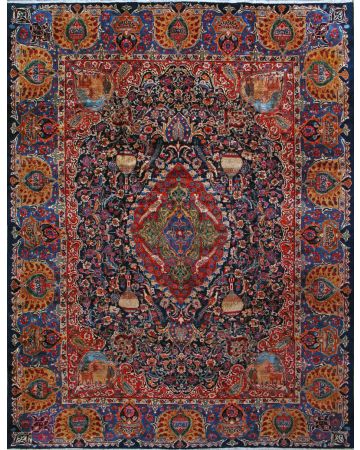The Art of Persian Rug Weaving - Craftsmanship and Tradition
Persian rugs are renowned for their intricate designs, vibrant colors, and unparalleled craftsmanship. The art of weaving Persian rugs is a centuries-old tradition that continues to captivate enthusiasts and collectors around the world. This remarkable craft blends artistry with technique, reflecting a deep cultural heritage and a profound respect for tradition.
The Weaving Process - A Symphony of
Techniques
At the heart of Persian rug weaving lies a meticulous process that
involves quite a lot of key steps, each demanding skill and precision. The
creation of a Persian rug begins with the selection of high-quality materials,
typically wool, silk, or cotton. Wool is favored for its durability and natural
sheen, while silk is used for its luxurious texture and ability to hold vibrant
dyes.
·
Design and Patterning
The process starts with designing the pattern of the rug, which often
involves complex geometric shapes, floral motifs, or intricate medallions.
Designs are influenced by regional traditions and historical periods,
reflecting the cultural and personal aesthetic of the weaver. Once the design
is finalized, it is transferred to graph paper or a scaled blueprint that
guides the weaving process.
· Dyeing the
Yarn
The yarn used in traditional Persian
rugs is dyed using
natural pigments derived from plants, minerals, and insects. This dyeing
process is crucial as it impacts the final appearance and longevity of the rug.
Weavers employ a wide variety of techniques in order to achieve different
shades and color intensities, making sure that the colors are vibrant and
long-lasting.
· Preparing the
Loom
Persian rugs are traditionally woven on horizontal looms. The loom is
set up with the warp threads (vertical threads) stretched tightly, creating a
sturdy base for the rug. These warp threads are then secured in place, allowing
the weaver to start the intricate process of knotting.
· Knotting the
Rug
The most distinctive feature of Persian rug weaving is the knotting
technique. Persian rugs typically use the asymmetric (Senneh) knot, where the
yarn is wrapped around two warp threads in a specific manner. This knotting
technique is labor-intensive but creates a dense, durable pile that enhances
the texture and longevity of the rug. Weavers often use a combination of
different knots to achieve complex patterns and textures.
· Weaving and
Finishing
As the weaver adds knots row by row, the design of the rug begins to
take shape. This stage requires meticulous attention to detail and a high level
of skill. Once the weaving is complete, the rug is carefully trimmed and
washed. The finishing process includes removing excess yarn, smoothing the
pile, and often adding fringe. The final touch is a gentle wash, which helps
set the colors and softens the texture.
Conclusion
The art of Persian rug weaving is a blend of artistic expression and
technical prowess. From the initial design to the final wash, every step in the
process showcases the weaver's skill and dedication. As a timeless tradition, hand knotted Persian
rugs available at ArmanRugs continue to be celebrated not just as
decorative items but as masterpieces of cultural heritage and craftsmanship.



Comments
Post a Comment